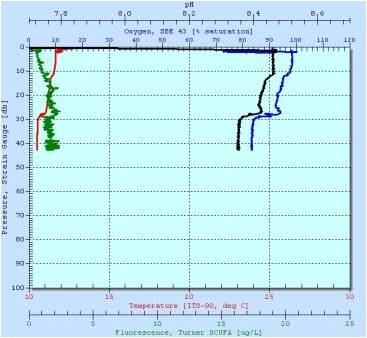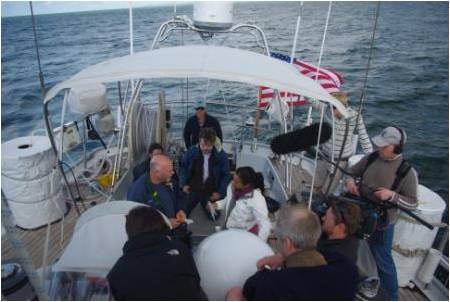First Sampling in Plymouth Reveals Interesting Blooms — BBC Cameras capture it all!

After a couple of days in Plymouth we were ready for the first of two intense sampling days together with the Plymouth Marine Laboratory (PML). We had heard rumours about blooms of Phaeocystis, a conspicuous bloom-former in the North Sea and English Channel. When it blooms, it turns the water reddish-brown in color, and the degradation of the gelatinous colonies may result in foaming. It was another beautiful sunny morning in Plymouth when we left Sutton Harbour and headed for one of PML’s long-term coastal sampling sites, L4 and L4 east. In addition to the permanent crew, Dr. Venter, Heather Kowalski (head of PR and communications) and Dr. Chris Dupont were onboard from JCVI. They were joined by a sampling team from PML of Dr. Jack Gilbert and two students, Nicole Bale and Ben Temperton, who were going to sample for transcriptomics, i.e. analysis of RNA to look at the expression of the genome. We also invited Dr. Dawn Field and her student Paul, bioinformatics experts visiting from Oxford, to join us.
We followed PML’s research vessel Plymouth Quest out to the sampling stations. This group, headed by Denise Cummings, conducted a suite of measurements to provide us with an incredibly detailed picture of what the sampled microbial community was actually doing.
We dropped our CTD down to just over 40 m and observed two interesting changes in temperature, oxygen and pH through the water column at 12 and 28 meters respectively and decided to take a sample at 35m and a surface sample. The step-like form of the temperature profile suggested that several storms had passed through recently, mixing the water, with quiescent weather in the intermittent periods. Potentially, the drops in oxygen and pH were the result of increases in community respiration, which consumes oxygen (just like when we humans breathe). The gradual increase in chl a with depth was due to photoadaptation, that is the plankton deeper in the water produce more of the light absorbing pigments because there is less light. Fortunately, each of these hypotheses can be directly addressed by the work being done by the group aboard the Plymouth Quest. Through collaboration with PML, we will know more about these samples than we have for any sample previously.

We were delighted to find our filters full of microorganisms after filtering 200 L of seawater from the two depths. Upon opening the filter casings, we were hit with a very tangy sulfidic aroma caused by dimethyl sulphide (DMS for short). This gas, which is literally the "smell of the sea," is the result of marine plankton degrading dimethylsulfoniopropionate (DMSP for sanity). Most phytoplankton produce lots of DMSP and the tiny animals and crustaceans that eat them are sloppy, so you essentially have a steady supply of DMSP to bacteria. Some bacteria actually want the sulphur so they metabolize the DMSP. Others degrade it to DMS, which gives you that peculiar smell. A curious side effect of DMS is that when in the atmosphere it acts as cloud condensation nuclei. In simpler terms, lots of DMS production means lots of clouds, which reflect the sun's energy away from Earth. Therefore, in direct contrast to the carbon dioxide, DMS is a "global cooling gas."
Just in time for the second sampling station we were met by a BBC film crew who motored up in a RIB boat. The crew from London was onboard to film the important work of the Sorcerer II Expedition and the collaboration with PML for a new science TV series to air later this year. Onboard the Sorcerer II, Dr. Venter, Chris Dupont and Jack Gilbert did an excellent job explaining our mission and the science behind it to the interested and professional BBC reporter, who also turned out to be helpful during the sampling procedure. It's never easy with so many people onboard the boat during these intensive samplings and having a film crew, some of whom don't have the greatest sea legs, adds to the intensity.

Earlier in the week the JCVI and PML teams had conducted some joint interviews in Plymouth while on the dock. These included a local newspaper and a BBC radio interview.
Click here to listen to one of the radio interviews.
(post by By Karolina Ininbergs and Chris Dupont)